Easy Photoshop Movie Posters Photoshop Movie Posters
In this tutorial, I show you how easy it is to blend images like a movie poster with Photoshop! We'll start by moving both of our images into the same document and positioning them where we need them. Then we'll blend the two images together using a layer mask. We'll help the images blend seamlessly together by adding a texture, converting the effect to black and white, and then colorizing it with our own color. And finally, we'll boost the contrast to create our final "movie poster"effect.
Here's what the final result will look like when we're done:
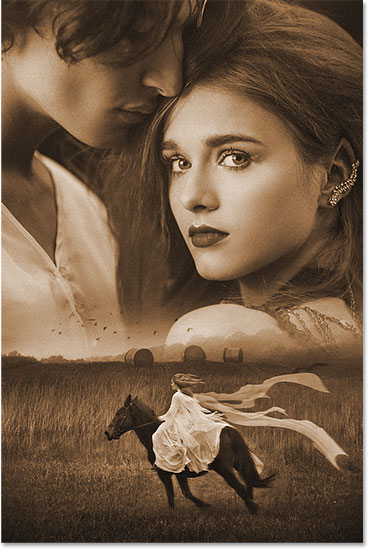
The final "movie poster" effect.
Let's get started!
How To Blend Images Like A Movie Poster
For this tutorial, I'm using Photoshop CC but every step is compatible with Photoshop CS6.
You can also follow along with my video of this tutorial on our YouTube channel. Or download this tutorial as a PDF and get my Complete Guide to Layer Blend Modes as a bonus!
Step 1: Open your images
To begin, open the images you want to blend together. Here's the first image I'll be using:
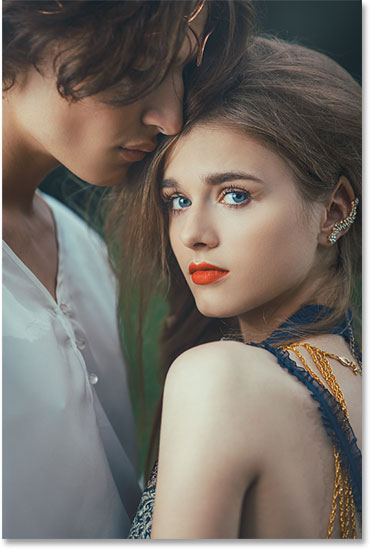
The first image. Photo credit: Adobe Stock.
And here's my second image. Both images were downloaded from Adobe Stock:

The second image. Photo credit: Adobe Stock.
Step 2: Move both images into the same document
At the moment, each image is in its own separate document. We need to move them into the same document. And the easiest way to do that is to drag an image from one document to another.
Select the Move Tool from the Toolbar:

Selecting the Move Tool.
Click on your image:
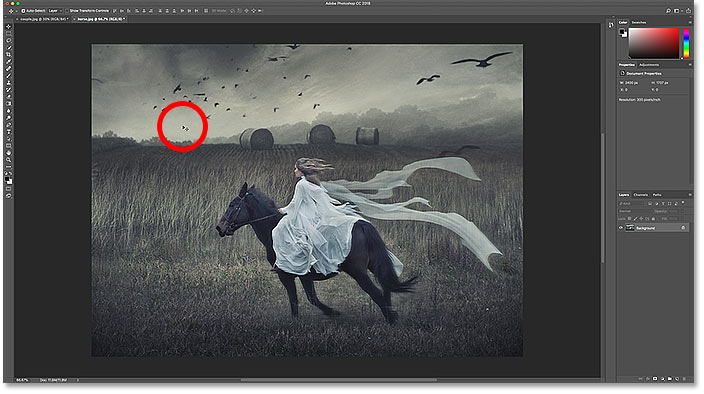
Clicking on the image with the Move Tool.
And then drag it up and onto the tab of the other document. Keep your mouse button held down and stay on the tab until Photoshop switches to the other image:

Dragging the image onto the other document's tab.
Then press and hold your Shift key and drag down into the document. Release your mouse button and Photoshop drops the image into place. The Shift key centers the image within the document:
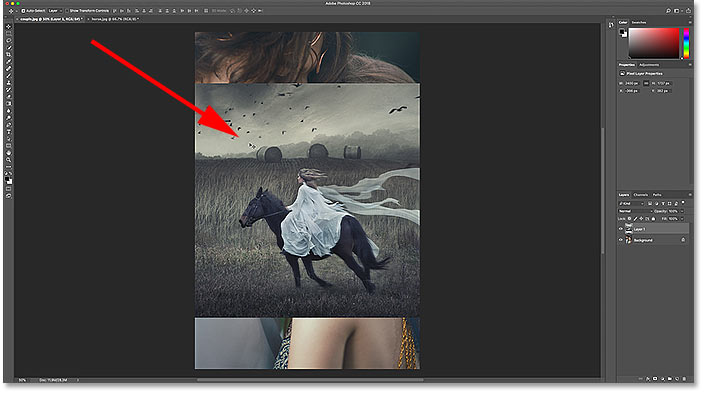
Holding Shift and dragging from the tab into the other image.
If we look in the Layers panel, we see both images, each on a separate layer, now in the same document:
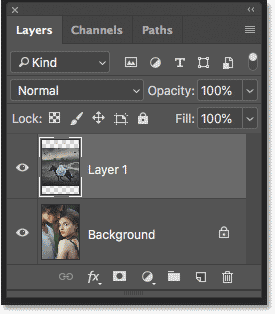
The Layers panel showing both images.
Step 3: Resize and move the image
At the moment, my horse image is too wide to fit within the other image, so I need to resize it. And I also want to move it from the center down to the bottom. I can do both of those things with Photoshop's Free Transform command.
To select it, go up to the Edit menu in the Menu Bar and choose Free Transform:
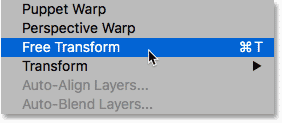
Going to Edit > Free Transform.
This places the Free Transform box and handles around the image:
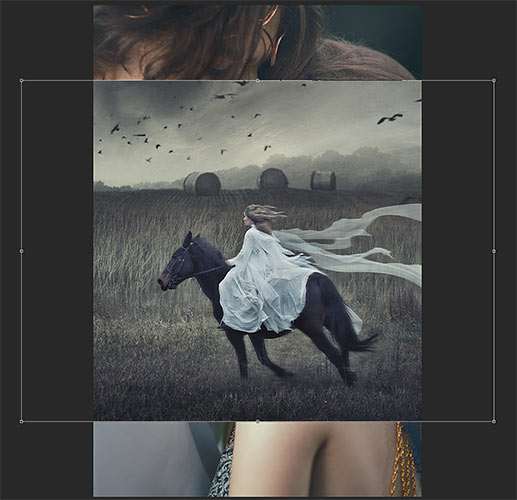
The Free Transform handles appear around the image.
Resizing the image
To resize it, press and hold your Shift key, along with the Alt (Win) / Option (Mac) key, as you click and drag any of the corner handles. The Shift key locks the aspect ratio of the image, and the Alt / Option key lets you resize the image from its center:
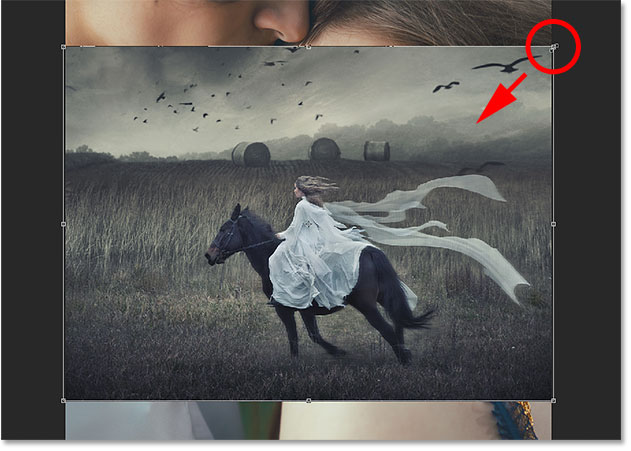
Hold Shift+Alt (Win) / Shift+Option (Mac) and drag the corner handles to resize the image.
Moving the image
Then, to move the image down to the bottom, I'll click inside the Free Transform box and I'll drag it into place. Hold your Shift key as you drag to make it easier to move straight down:
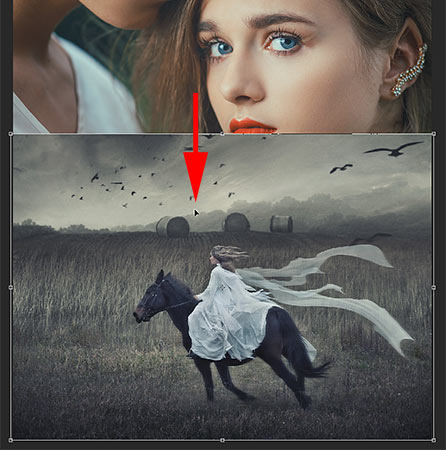
Holding Shift and dragging the image down to the bottom.
To accept it, press Enter (Win) / Return (Mac):
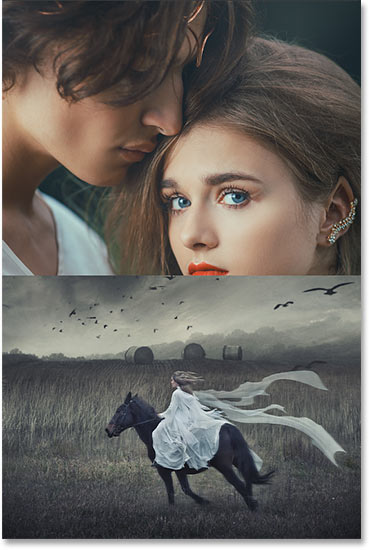
The image has been resized and moved into place.
Step 4: Move the other image (optional)
I also want to move the other image higher up in the document. But in the Layers panel, we see that the image is currently sitting on the Background layer, and Photoshop won't let us move an image while it's on the Background layer:
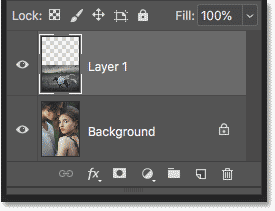
The image of the couple sits on the Background layer.
Unlocking the Background layer
To fix that, in Photoshop CC, click on the lock icon. In Photoshop CS6, press and hold Alt (Win) / Option (Mac) and double-click on it:
Unlocking the Background layer.
This unlocks the Background layer and renames it "Layer 0":
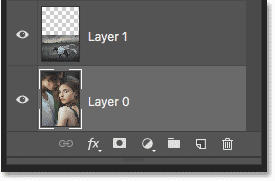
The Background layer has been renamed.
Moving the image
Make sure "Layer 0" is selected, and then with the Move Tool still selected, click on the image and drag it up and into place. Again, hold Shift as you drag to make it easier to drag straight up:
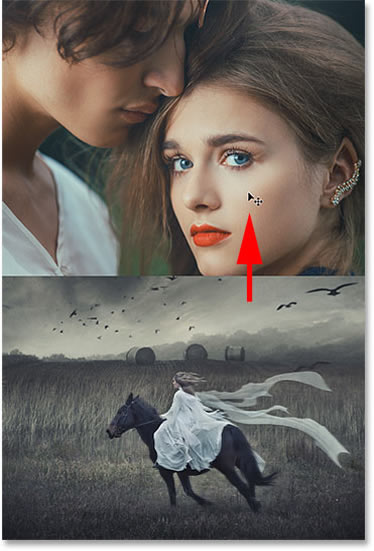
Dragging the original image higher up in the document.
Step 5: Add a layer mask
Once the images are in place, we can blend them together. And we'll do that using a layer mask. Back in the Layers panel, click on the image on the top layer to select it:
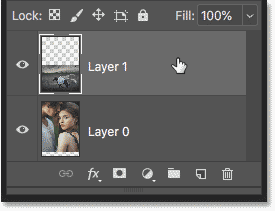
Selecting the top layer.
Then click the Add Layer Mask icon:

Adding a layer mask.
A layer mask thumbnail appears on the top layer:
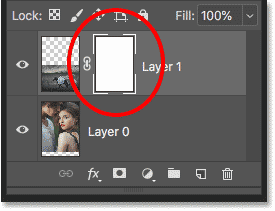
The layer mask thumbnail.
Step 6: Draw a black to white gradient on the mask
In the Toolbar, select the Gradient Tool:

Selecting the Gradient Tool.
Then in the Options Bar, make sure the Black, White gradient is selected:

The gradient swatch showing the Black, White gradient.
If it isn't, click on the arrow next to the gradient swatch, and then double-click on the Black, White gradient's thumbnail (third from the left, top row) to select it:
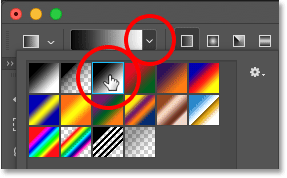
Selecting the Black, White gradient.
Also in the Options Bar, make sure that the gradient type is set to Linear:

Setting the gradient type to Linear.
Then, click in the document and drag out a black to white gradient across the spot where you want the two images to blend together. In my case, I'll click just below the top of my horse image to set the starting point for the gradient. Then, to create a smooth transition between the two images, I'll drag down to the top of the hill:
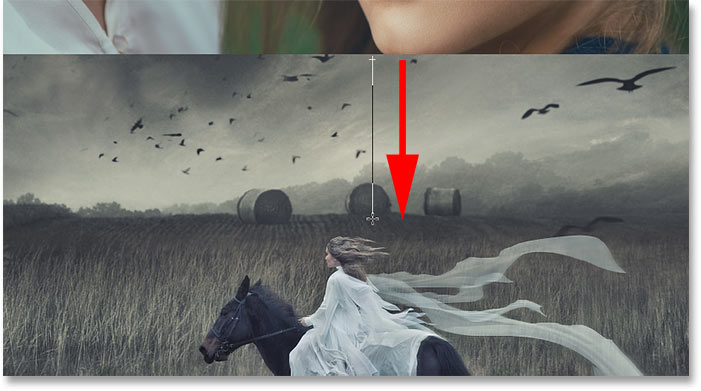
Drawing a gradient to blend the two images together.
Release your mouse button, and Photoshop draws the gradient on the layer mask and blends the images:
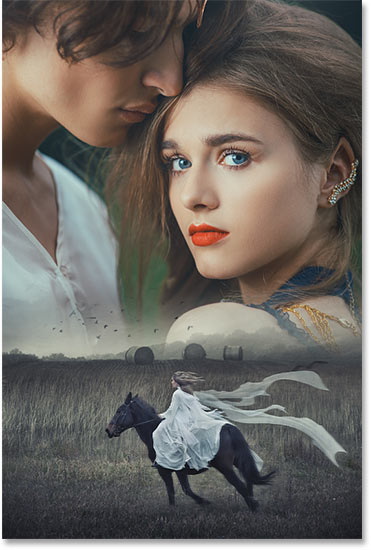
The images now blend where the gradient was drawn.
Back in the Layers panel, we see our gradient in the layer mask thumbnail. You can learn more about layer masks, and other ways to blend images in Photoshop, in my blending images tutorial:

The layer mask thumbnail showing the gradient.
Step 7: Merge the layers
Next, we need to merge the two layers onto a new layer above them. Make sure the top layer is still selected. Then, on a Windows PC, press Shift+Ctrl+Alt+E on your keyboard. On a Mac, press Shift+Command+Option+E. This merges both layers onto a new layer:
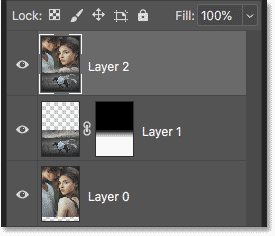
The images have been merged onto a new layer.
Step 8: Add noise
To help the images blend more seamlessly together, we'll add a subtle texture. Go up to the Filter menu, choose Noise, and then choose Add Noise:

Going to Filter > Noise > Add Noise.
In the Add Noise dialog box, set the Amount to around 2 to 4% depending on the size of your images. Choose Gaussian and Monochromatic, and then click OK:
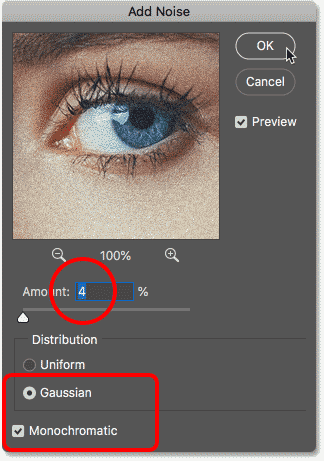
The Add Noise filter settings.
If I zoom in closer, we see how the texture helps to unify the two images:
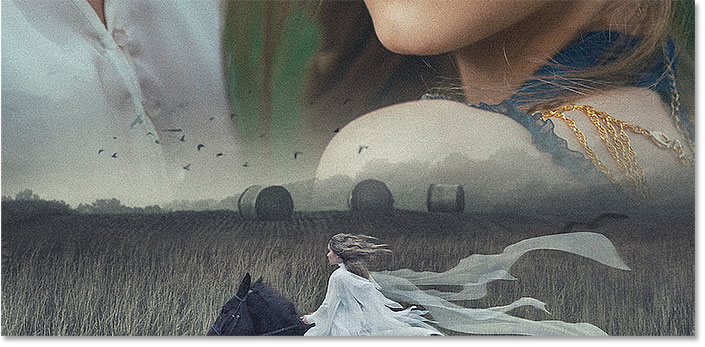
The noise creates a texture across both images.
You can toggle the texture on and off to compare the results by clicking the visibility icon for the merged layer in the Layers panel:
Toggle the noise on and off with the visibility icon.
Step 9: Convert the images to black and white
The only problem at this point is that the colors in the images don't match. Let's fix that by converting the images to black and white, and then colorizing them with our own color.
In the Layers panel, click the New Fill or Adjustment Layer icon:
Adding a new fill or adjustment layer.
Then choose Black & White form the list:
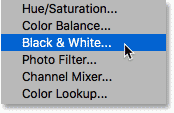
Choosing a Black & White adjustment layer.
This instantly converts the images to black and white:
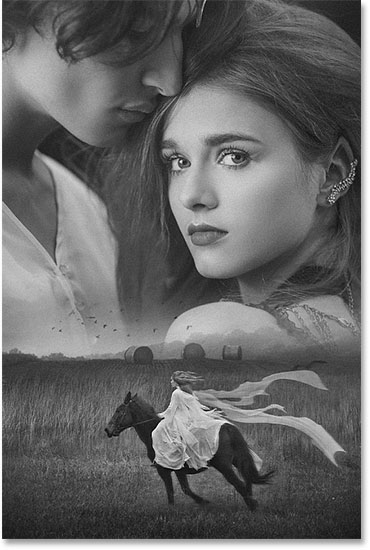
The initial black and white conversion.
Customizing the black & white conversion
In the Layers panel, we see the new Black & White adjustment layer:
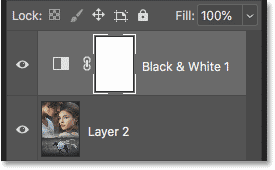
The Black & White adjustment layer.
And the controls for the adjustment layer appear in the Properties panel. To customize the black and white version, start by clicking the Auto button:
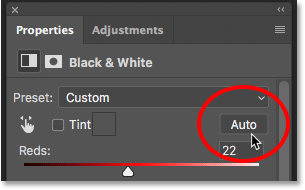
Clicking the Auto button.
Photoshop will choose its own settings for the effect:
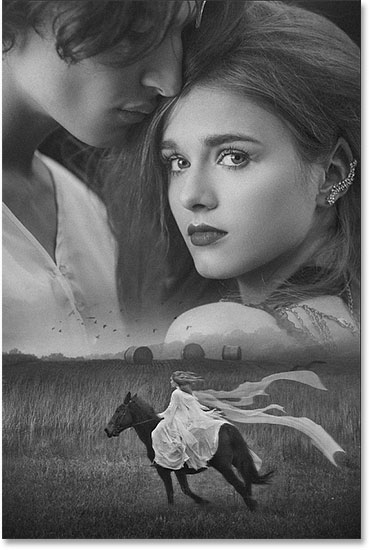
The Auto black and white conversion.
To customize it further, click and drag the color sliders to adjust the brightness of different parts of the image based on their original color. For example, dragging the Reds slider will lighten or darken any areas that contained red. Dragging the Yellows slider will affect areas that contained yellow, and so on:
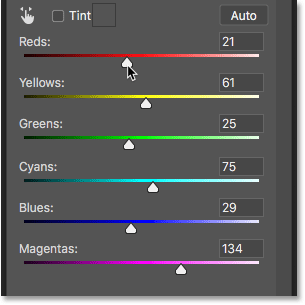
Use the color sliders to create your own custom black and white version.
Continue dragging the sliders until you're happy with the results:
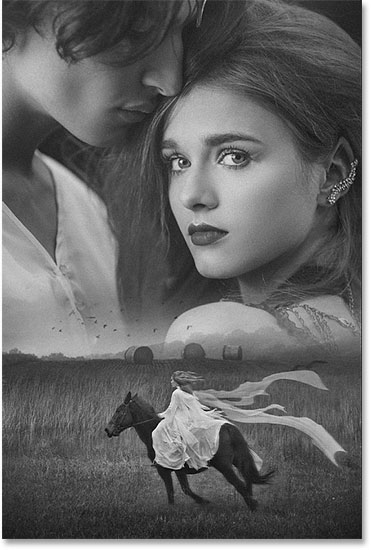
The custom black and white version.
Step 10: Colorize the effect
So now that we've removed the original colors, let's colorize the effect with our own color. And the easiest way to do that is with a Hue/Saturation adjustment layer.
Back in the Layers panel, click again on the New Fill or Adjustment Layer icon:
Clicking the New Fill or Adjustment Layer icon.
And then choose Hue/Saturation:
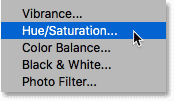
Adding a Hue/Saturation adjustment layer.
In the Properties panel, select the Colorize option:
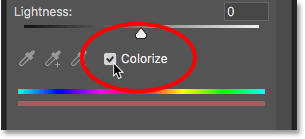
Clicking "Colorize".
Choose a color by dragging the Hue slider. I'll set my Hue value to 30. Then set the intensity of the color with the Saturation slider. I'll again set mine to 30:
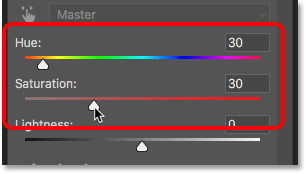
Choosing a color and saturation value with the sliders.
Once you've chosen your color, go back to the Layers panel and change the blend mode of the Hue/Saturation adjustment layer to Color. This way, we're affecting only the colors in the image, not the brightness values:
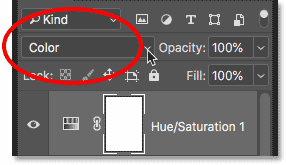
Changing the blend mode to Color.
And here's the result:

The result after colorizing the effect.
Step 11: Increase the contrast
Finally, if you need to boost the contrast in the effect, click again on the New Fill or Adjustment Layer icon in the Layers panel:
Clicking the New Fill or Adjustment Layer icon.
And this time, choose Levels:
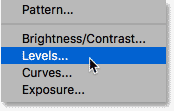
Adding a Levels adjustment layer.
Change the blend mode of the Levels adjustment layer from Normal to Soft Light:
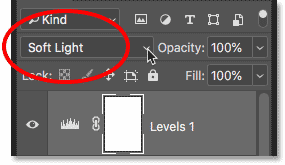
Changing the blend mode to Soft Light.
This instantly increases the contrast:
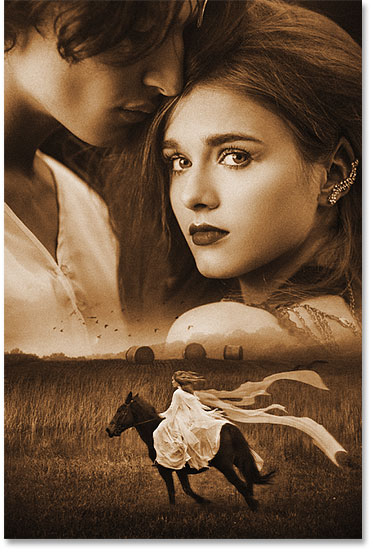
The result after changing the blend mode to Soft Light.
If the contrast is too strong, just lower the opacity of the Levels adjustment layer to fine-tune the results. I'll lower mine to 35%:
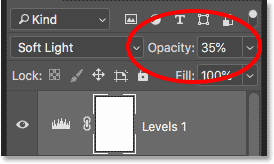
Lowering the opacity of the Levels adjustment layer.
And here, after lowering the opacity, is my final result:

The final "movie poster" effect.
And there we have it! That's how to easily blend photos like a movie poster with Photoshop! Visit our Photo Effects section for more tutorials. And don't forget, all of our Photoshop tutorials are now available to download as PDFs!
Source: https://www.photoshopessentials.com/photo-effects/blend-photos-lmovie-poster-photoshop/
0 Response to "Easy Photoshop Movie Posters Photoshop Movie Posters"
Post a Comment